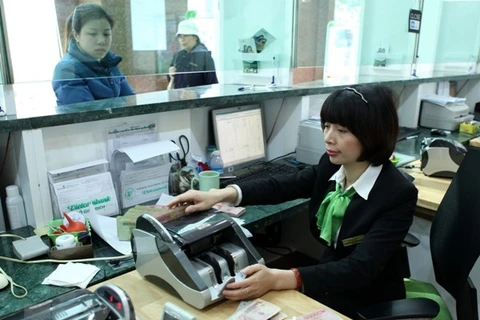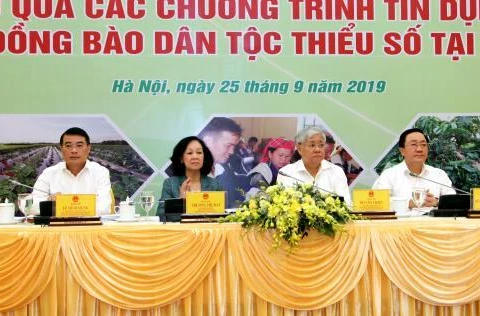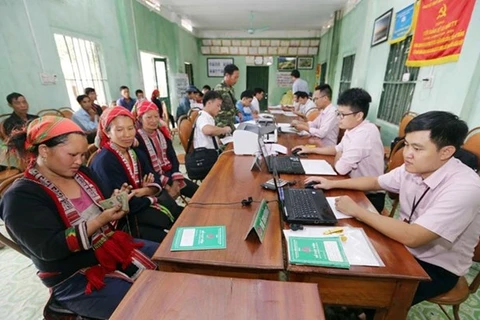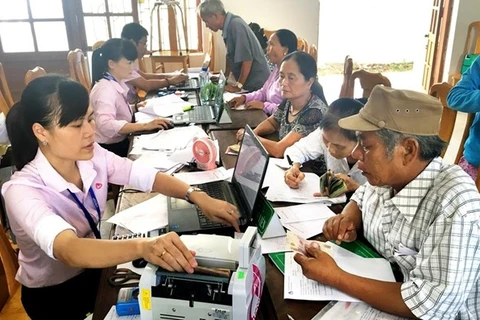 The policy credit benefits nearly 2.2 million poor households and other policy beneficiaries in 2019. Tran Lan Phuong, Deputy General Director of the Vietnam Bank for Social Policies. (Photo: VietnamPlus)
The policy credit benefits nearly 2.2 million poor households and other policy beneficiaries in 2019. Tran Lan Phuong, Deputy General Director of the Vietnam Bank for Social Policies. (Photo: VietnamPlus) Hanoi (VNA) - The policy credit has come to all communes, wards and townships across the country, with priority given to poor and near-poor households.
Right from the early days of 2019, the Vietnam Bank for Social Policies (VBSP) has actively followed the Government's Resolution No. 01/NQ-CP on the major tasks and solutions to implement the socio-economic development plan and State budget estimate. Therefore, The policy credit has reached many poor households.
Nearly 2.2 million households have access to preferential loans
Tran Lan Phuong, VBSP Deputy General Director, said that in 2019, the policy credit benefited nearly 2.2 million poor households and other policy beneficiaries. This was one of many outstanding achievements of the bank last year, contributing to supporting poor and near-poor households and those who have just got out of poverty to raise incomes, reduce poverty sustainably, and promote socio-economic development.
Besides, thanks to this capital, more than 266,000 labourers had jobs and more than 36,000 students in difficult circumstances accessed loans to continue their study. Over 1.2 million clean water supply and rural environmental sanitation works as well as nearly 20,000 houses for poor households and policy beneficiaries were built.
Huong also said that the policy credit has come to all communes, wards and township across the country, with priority given to poor and near poor households and those who have just escaped from poverty and communes in ethnic minority-inhabited, extremely difficult, remote and border areas.
Especially for localities damaged by natural disasters and epidemics, in addition to timely visits, the VBSP has directed the provision of additional capital to support the poor and other policy beneficiaries to obtain loans to restore production.
In order to ensure sufficient capital for the implementation of policy credit programmes, the bank has taken many measures such as well implementing the issuance of bonds in line with the approved plan, receiving 2-percent deposits of State-owned credit institutions, strengthening the mobilisation of deposits from organisations and individuals at the headquarters of the VBSP and its communal transaction points.
In particular, the VBSP has actively recovered the due debts of programmes to offer revolving credit, with a total amount of over 54 trillion VND (2.33 billion USD), an increase of 8.18 trillion VND compared to 2018, equal to 74 percent of total loans.
Along with promoting the disbursement of policy credit programmes, the bank has implemented synchronous measures to consolidate and improve credit quality. As of December 31, 2019, overdue and charged-off debts were over 1.43 trillion VND, accounting for 0.69 percent of the total outstanding loans.
Phuong also emphasised the closer coordination between the bank and socio-political organisations and local authorities in offering policy credit and the increasingly efficient use of capital by the poor and other policy beneficiaries.
 A total of 42,157 loans worth over 3 trillion VND were provided for poor and near-poor households, those who have just escaped from poverty, and ethnic minority families, as of December 31, 2019. Illustrative image (Photo: VietnamPlus)
A total of 42,157 loans worth over 3 trillion VND were provided for poor and near-poor households, those who have just escaped from poverty, and ethnic minority families, as of December 31, 2019. Illustrative image (Photo: VietnamPlus)
Effect of loan amount and term raising programme
Over the past time, based on the opinions of borrowers and voters nationwide, National Assembly deputies and local governments proposed raising the maximum loan amount for poor and near-poor households and those just getting out of poverty and social policy credit programmes for production and business development.
Therefore, from March 1, 2019, the Vietnam Bank for Social Policies increased the maximum loan amount for poor households from 50 million VND per household to 100 million VND per household without a collateral. The maximum loan term was increased to 120 months for poor households to meet their long-term investment demand.
“This is a sound policy that is appreciated by the local authorities and people. It has created conditions for poor and near-poor households and those who has just got out of poverty, and ethnic minority families to obtain loans for production and business development,” said Dao Anh Tuan, head of the VBSP’s Student Credit Department.
According to statistics, as of December 31, 2019, a total of 42,157 loans worth over 3 trillion VND were provided for poor and near-poor households, those who have just escaped from poverty, and ethnic minority families.
Tuan noted that these credit programmes have met the needs of the borrowers, helping them stay away from illegal forms of credit with high interest rates (also called black credit). This is seen as one of the solutions to limit and repel black credit, in accordance with the State policy.
According to Phuong, 2020 is the last year to implement the development strategy of the VBSP for the 2011-2020 period. Therefore, the bank has strived to well implement the credit plans assigned by the Prime Minister, prioritised lending to poor and near-poor households, those just getting out of poverty, communes in ethnic minority, extremely difficult, remote and border areas as well as regions hit by natural disasters, in combination with national target programmes on sustainable poverty reduction and new-style rural area building./.
























